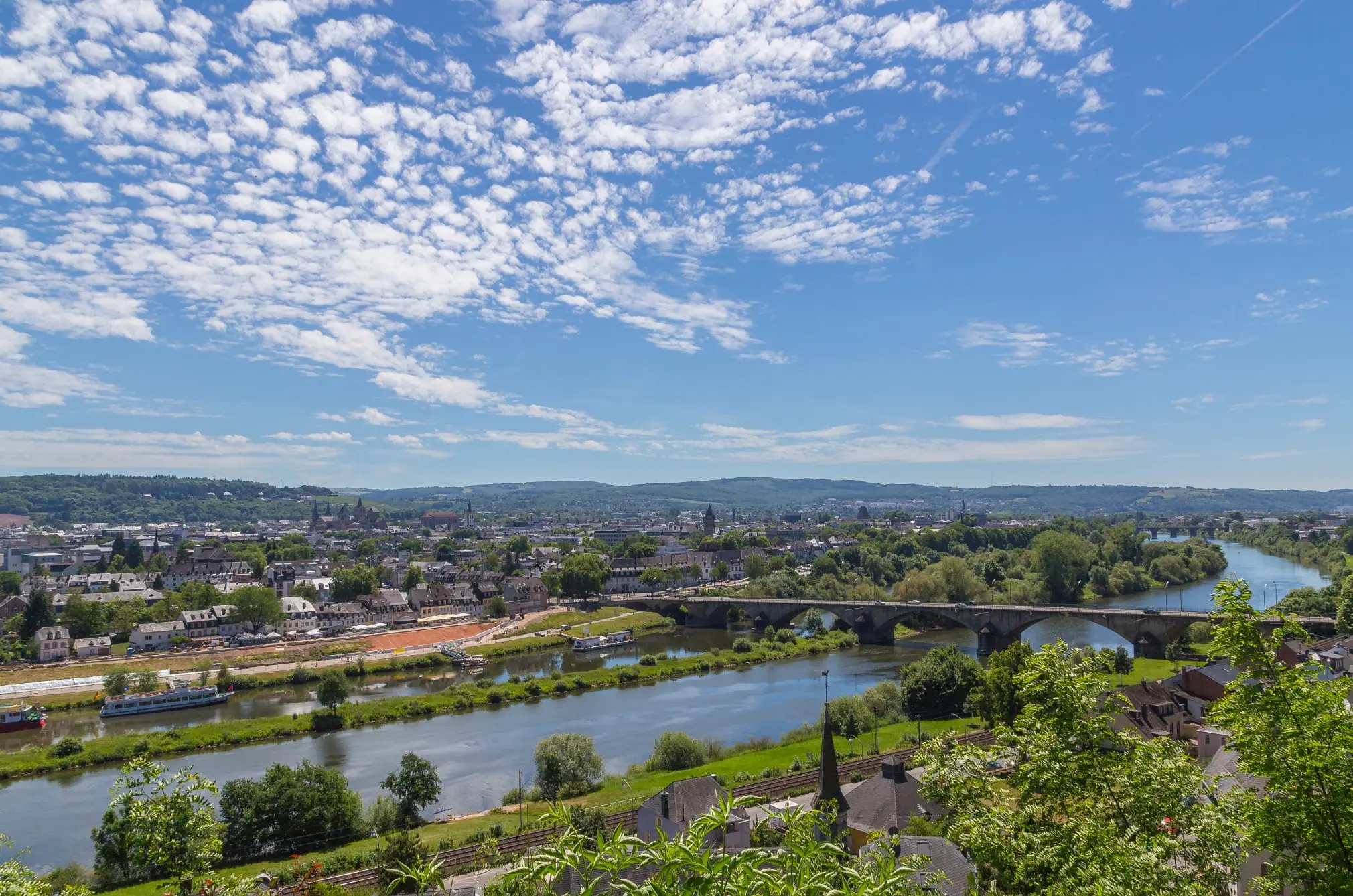
1. TRIER AUDIOGUIDE. WELCOME TO TRIER.
Imagine a place where the shadows of the past blend with modern bustle, where ancient stones whisper tales of emperors and gladiators. Welcome to Augusta Treverorum, known today as Trier, one of Germany's oldest cities, with a history that stretches back over two thousand years.
According to legend, the city was founded much earlier than the Roman era by Trebeta, a prince from the Assyrian Empire, an ancient region of Upper Mesopotamia. The legend tells that he fled his homeland and founded a city in the unknown lands of Europe, which would later become known as Trier, approximately 1,300 years before the founding of Rome. Of course, this is a story that challenges the historical record and is probably best enjoyed with a pinch of imagination and a good Moselle wine in hand.
Our journey begins when a Celtic tribe, the Treveri, decided to settle along the winding Moselle River. They were the ones who named what would be a settlement destined for greatness. This tribe was engaged in trade, taking advantage of the fertility of the land and the richness of the natural resources. But it was under the yoke of the Roman eagle that Augusta Treverorum would truly be born.
The city's Roman legacy came to life in 16 BC when the Romans, led by Emperor Augustus in his eternal thirst for expansion, established a military camp at the site. Little did they know that they were planting the seeds of a city that would one day be known as 'the second Rome north of the Alps.'
As the city grew in importance, so did its architecture. The Roman Bridge of Trier, which still stands proud after millennia, is a silent witness to the ingenuity and skill of Roman engineering. Imagine walking on the same stones as Roman soldiers, merchants, and pilgrims. It's a tangible connection to the ancestors of the city.
But it's not just the bridge that awakens wonder. The Porta Nigra, a city gate that survives to this day, serves as the portal to Trier's past. It was here that the Romans showed their love for things grand and timeless. Its name, which means 'black gate,' comes from the darkening of its light gray stones over the centuries. Crossing this threshold, one can almost hear the echo of Roman chariots and the bustle of city life.
The zenith of Augusta Treverorum came in the 4th century when it was proclaimed the capital of the prefecture of the Gauls. Emperors like Constantine the Great, a guy who knew how to impress his friends and scare his enemies, embellished the city with monumental structures. The Basilica of Constantine, which now serves as a church, was at that time a throne room, a symbol of imperial power that dominated the city. It had to be so large that echoes had echoes. Legend has it that you could hear someone yawning in it days later.
But perhaps nothing better represents Trier's ancient grandeur than the Imperial Baths. Designed not only for cleansing but also for socializing and business, these baths were a hub of daily life. Imagine yourself immersed in warm waters, surrounded by the opulence of mosaics and columns, as business and gossip flow as freely as the thermal waters.
As the Roman Empire waned, Augusta Treverorum withstood various invasions, declines, and rebirths. In the Middle Ages, the city transformed into an important ecclesiastical center, with the impressive Trier Cathedral, which houses a revered relic: the Holy Robe, supposedly the tunic Jesus wore before his crucifixion. The Bishop of Trier, Saint Maternus, is one of the first bishops known outside Italy. In 895 it was the seat of an ecclesiastical council, a testament to its religious importance in medieval Europe.
Subsequent centuries saw Trier flourish and suffer through wars, shifts of power, and revolutions. Each era left its mark, from the prince-electors of the Holy Roman Empire to the warlords of the Napoleonic era. Trier was occupied by France on several occasions in its history. The city was formally annexed by France in 1794 during the French Revolutionary Wars and became part of the Sarre department. It was not until the Congress of Vienna in 1815 that Trier was handed over to Prussia. Trier did not escape the conflict of World War II. It suffered significant damage from bombings, but many of its historical structures, including the Porta Nigra, survived or were restored after the war. The city, like an ancient book, has chapters written in the stone of its buildings, in the curves of its streets, and in the flow of its river.
Today, Trier is a treasure trove of living history. Walking through its streets, which have seen more drama than an entire season of your favorite TV series, is to travel through the centuries. The market square, with its colorful Renaissance and Baroque-style buildings, bubbles with everyday life as it has done for hundreds of years. Cafes and shops invite locals and tourists alike to enjoy the hospitality of Trier, a hospitality that is as old as the city itself.
But don't just stick with ancient history; Trier is also a city of learning and culture. The University of Trier, founded in the 15th century, is a bustle of youth and education, a place where the future is shaped with the wisdom of the past. Although it was closed during the Napoleonic period, it was refounded in the 20th century and remains an important center of higher education.
On your visit to Trier, don't forget to taste the region's wine. Viticulture here dates back to the Romans, who knew that the Moselle Valley offered perfect conditions for cultivating vines. The rolling hills around Trier still host vineyards that produce some of the world's finest Rieslings. The local Riesling is so good it might make you recite poetry in Latin after a few sips.
As you bid farewell to Trier, you will take with you more than memories and photographs. You will carry the feeling of having been in a place where every stone, every street, and every building has a story to tell. Augusta Treverorum, with its glorious past and vibrant present, is more than a city. It is a continual dialogue with history, a crossroads of times and cultures, a place where you can touch the heart of European history. Trier Audioguide.
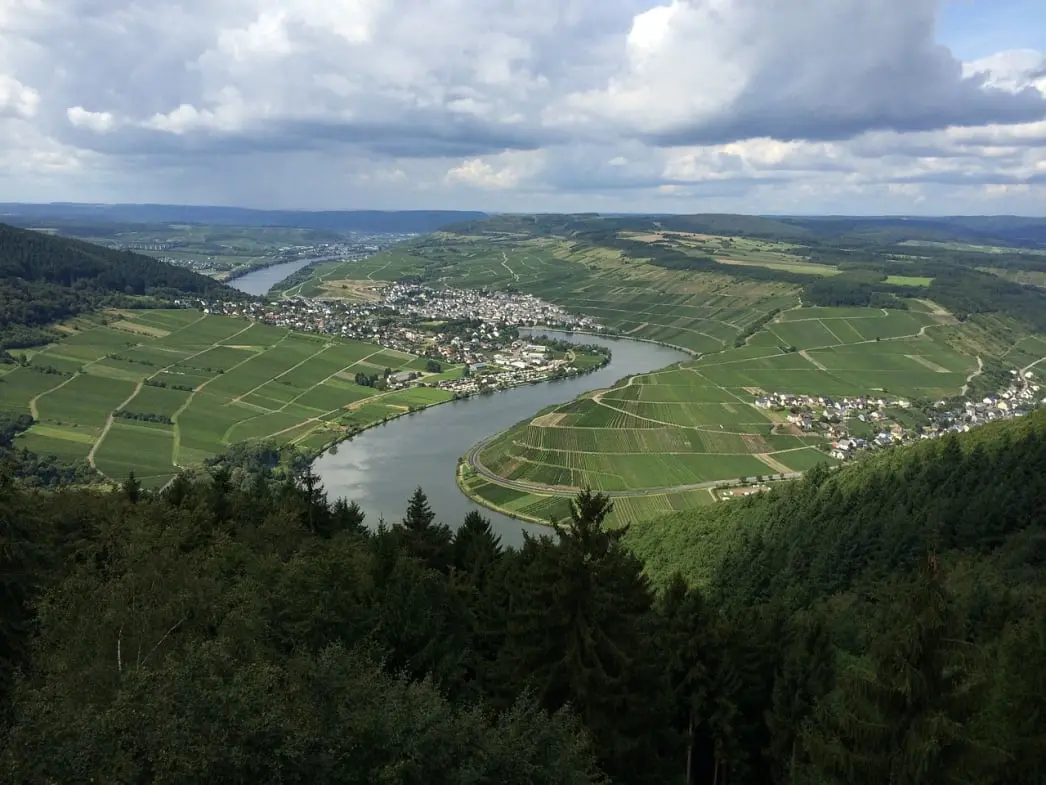
2. TRIER AUDIOGUIDE. THE PORTA NIGRA.
Imagine the 2nd century A.D., when the Romans roamed the region, aiming to make Trier a star in the firmament of their domains. "We need a monumental entrance," they must have thought, and indeed they achieved it. Constructed with massive blocks of local sandstone so large that even today we wonder if there were giants on the workforce, the Porta Nigra was erected to be much more than a gateway: it was a declaration of power, a "we are here to stay" etched in stone.
The gate was built around 170 A.D. as part of the city's fortifications. It was constructed using huge blocks of grey sandstone without mortar, and iron clamps were used to hold the blocks together, some of which can still be seen today. Originally, the gate would have been used as a defensive point for the city. It had two massive towers and doors that could be closed, and it would have been equipped with all the necessities of a fortress. The technique used to build the Porta Nigra was advanced for its time and highlights the level of technical knowledge that the Romans possessed in architecture and engineering.
But why "Black"? No, it's not because the Romans were going through a gothic phase. Over the centuries, erosion and pollution conspired to darken its stones, and so, like a good coffee, it acquired a patina that improved with age, and with it, a new name.
Here comes the curious part: during the Middle Ages, in the 11th century, a particularly devout individual, a Greek monk hermit named Simeon (who must have thought the gate was divinely good for prayer), moved into the Porta Nigra. The place was transformed into a church, and Simeon, into a saint. For a while, the most impressive of Roman gates was also a place of pilgrimage. The gate underwent significant modifications during this conversion, including the addition of two floors and a chapel.
The story of Simeon, who was later sanctified, is part of the local folklore. He locked himself in the structure, seeking a life of prayer and solitude, and hishermitic life eventually led to the building's transformation into his place of worship.
But then came Napoleon, that history buff who wandered through Europe with his agenda of renovations. When he laid eyes on the Porta Nigra, he exclaimed, "What a barbarity, to turn a Roman relic into a church!" So he ordered the ecclesiastical additions to be cleared and the gate to be restored to its former Roman splendor, thus removing the elements added for its use as a church.
When Napoleon's troops arrived in Trier at the end of the 18th and beginning of the 19th centuries, the Rhine region, including Trier, had fallen under French control. Napoleon had a great fascination with Roman culture and architecture, which he valued as the foundations of Western civilization and a symbol of the power and stability that he himself aspired to emulate in his Empire.
Napoleon, recognizing the historical and cultural value of the Porta Nigra, ordered that the structure be restored to its original state as a Roman monument. This decision was of great importance, as it marked one of the first examples of historical conservation with the aim of restoring a monument to its original state. Napoleon helped to initiate a wave of interest in the preservation of historical heritage, a concept that would gain strength in the 19th and 20th centuries, leading to the creation of organizations dedicated to the conservation of cultural heritage.
Thus, under Napoleon's orders, the Porta Nigra was stripped of the ecclesiastical elements and was partially restored to its appearance as a Roman fortress. The restoration work removed altars, holy images, and other Christian elements. While the restoration did not return the structure to its exact original Roman form, it did restore much of its character and prepared it to be recognized as the Roman city gate it once was.
If stones could speak, oh, the stories they would tell: about the Roman sentinels watching from its battlements, the merchants passing through its arches, and the city dwellers mingling in its shadow, discussing politics, market prices, or the latest chariot races.
Today, as you walk through the Porta Nigra, you can feel like a time traveler. With every step, you are following in the footsteps of the Romans, crossing the threshold between the past and present. Climb the narrow stairs to the ancient parapets and look out over the city as the guards did millennia ago. Imagine the bustling life unfolding before their eyes: chariots, togas, and the vibrant energy of an empire at its peak. Trier Audioguide.
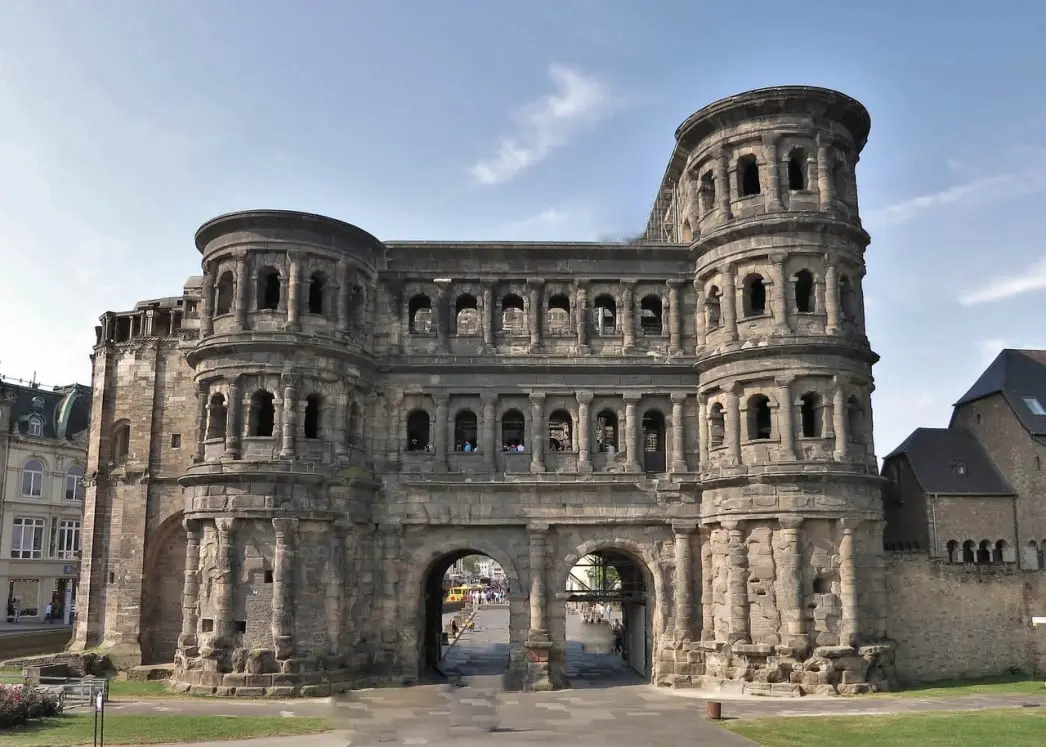
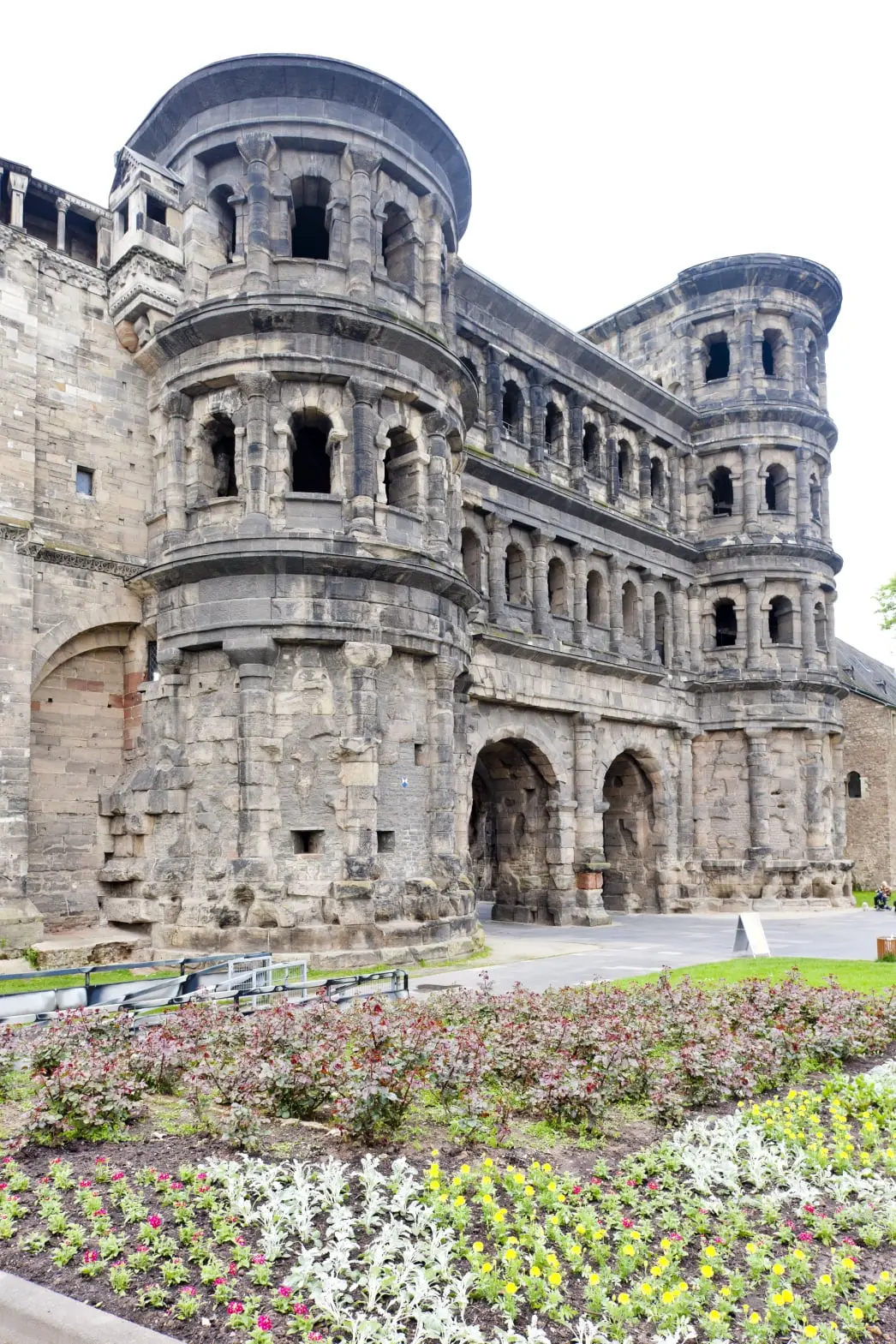
3. TRIER AUDIOGUIDE. THE BASILICA OF CONSTANTINE: A COLOSSAL BRICK EDIFICE WITH IMPERIAL ROOTS.
If walls could talk, the Basilica of Constantine, also known as the Aula Palatina, would tell us an epic tale worthy of any Hollywood blockbuster.
Picture yourself stepping back to 310 AD, at the zenith of Roman power. Constantine the Great decides he needs a throne hall as awe-inspiring as his own ego. And voilà! The Basilica of Constantine is constructed, an audience hall that was the ancient equivalent of a horizontal skyscraper.
At 67 meters long, 27 meters wide, and 30 meters high, this brick and stone behemoth was a symbol of power. Originally an aula or covered Roman gallery, it houses the most extensive room that has survived to modern times from classical antiquity. Its original design was marked by its monumentality and simplicity. The main hall, devoid of internal columns, created a massive rectangular space, which was a significant architectural feat for its time. The ceiling height and the length of the main nave were simply extraordinary for their era and continue to impress visitors today.
The basilica functioned as the imperial throne or aula, the place where the emperor conducted his administration and received important visitors, a locus of power.
With the fall of the Roman Empire, the basilica had to reinvent itself more times than an actor in search of a lifetime role. In the 5th century, it was converted into a fortress. Later, in the Middle Ages, it transformed into the residence of the bishops of Trier, and eventually, in the 18th century, into the Church of St. Saviour.
The Basilica has withstood fires, earthquakes, and wars. Napoleon used it as a stable for his horses during his European campaign, and the Second World War left it in ruins. But, like an action hero in a film, it always rises again.
Restored to its former splendor, the basilica now stands as a spectacular open space, a Protestant church that resonates with organ music instead of imperial oratory. The interior is a minimalist time capsule; devoid of the columns and statues characteristic of imperial Rome, yet it still retains its majestic essence. The restoration effort was aimed at preserving the look and feel of the original Roman space, though the interior is now much more austere and reflects the Protestant style of worship.
Do not miss the play of light that filters through the windows, animating the walls in a way that Constantine himself would surely approve. Trier Audioguide.
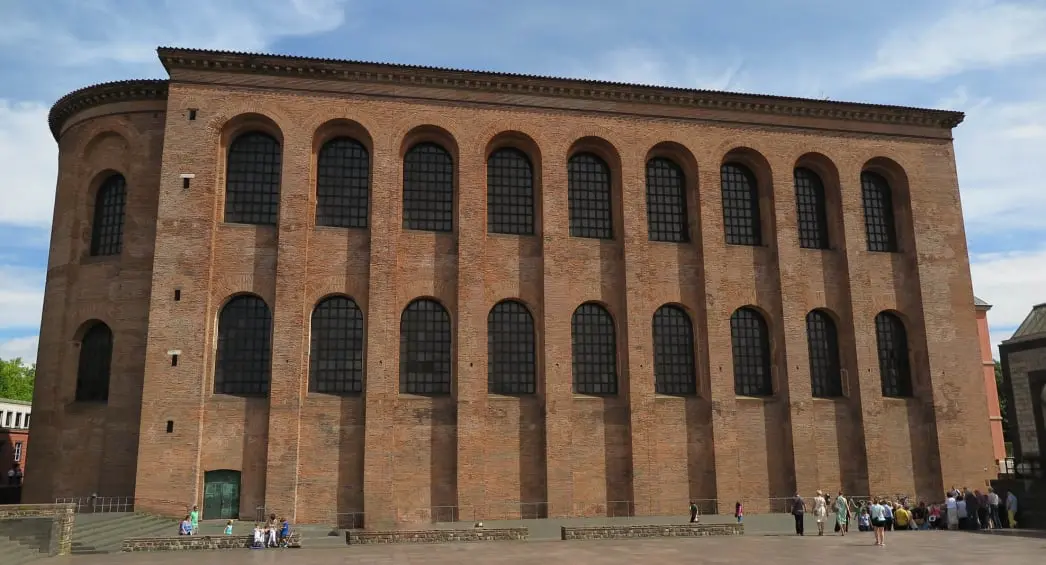
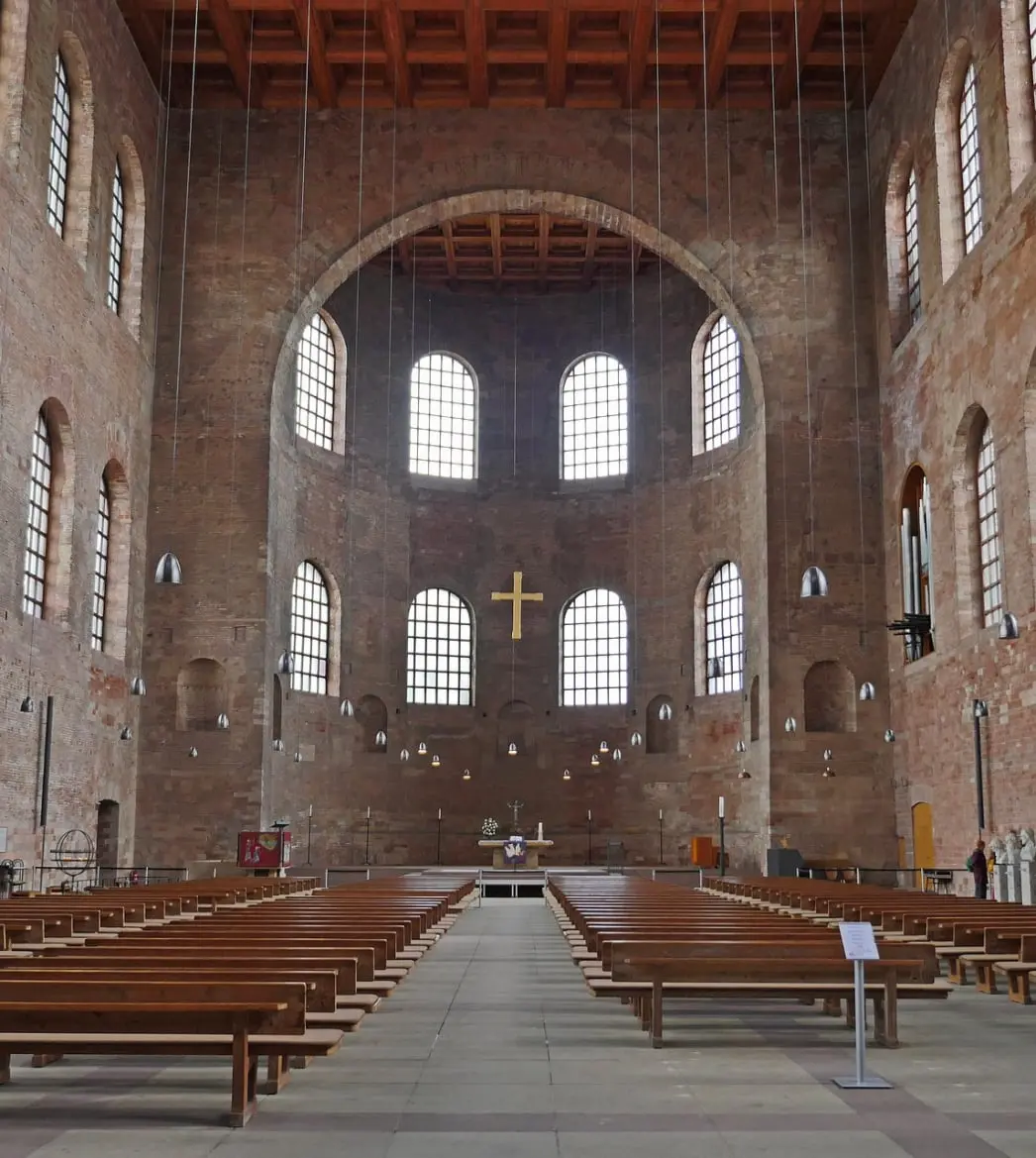
- Language german
- mp3 format
- Language english
- mp3 format
4. TRIER AUDIOGUIDE. TRIER CATHEDRAL.
Ladies and gentlemen, don your pilgrim sandals and adjust your halos, for the history of Trier Cathedral is so divinely complex it would have Saint Thomas Aquinas scratching his head. Also known as the Cathedral of Saint Peter, it has been the most important site of Christian pilgrimage in Western Christendom and one of the oldest continuously used churches in the world.
Over the centuries, Trier Cathedral has undergone numerous reconstructions. Destroyed, rebuilt, expanded, and embellished, the cathedral is like the phoenix of churches: always rising from its ashes, bigger and better than before.
What makes Trier Cathedral so special is its mix of styles over its more than 1,700 years of history. There are parts that shout "Gothic!" with spire-like arches reaching for the heavens, while others whisper "Romanesque" with such reliable stone robustness. Its thick Roman walls still stand firm, some even contain bricks that were laid by the hands of fourth-century workers.
Our story begins in the fourth century, the cathedral has its roots in what was originally a Roman palace house. For all we know, soon, this house was transformed into a Christian basilica, possibly ordered by Emperor Constantine the Great. Constantine was notable for his conversion to Christianity and for establishing Christianity as the dominant religion of the Roman Empire. This era is evidenced in its robust walls and in the rectangular floor plan of the original basilica. The Roman remains in the structure include massive, square pieces that were part of the building complex that was once a palace.
Fast forward to the 11th century, the cathedral was extensively rebuilt in Romanesque style, which is characterized by its massiveness and strong structure. The thick walls and barrel vaults are typical of this style and create an interior space that conveys a sense of protection and eternity. The Romanesque arches are semicircular, giving a feeling of solidity and stability.
During the 13th century, Gothic elements were added, which can be seen in expansions and reconstructions, such as the Gothic Chapel of Our Lady. The Gothic style is easily identifiable by its pointed arches, ribbed vaults, and large stained glass windows, which allow light to transform the interior space, filling it with color.
Later on, during the Renaissance and Baroque period, chapels and decorative elements were added that show a preference for ornamentation, geometric shapes, and classical proportions. These styles are evident in the decoration and furnishings of the cathedral, which incorporate a richness and detail that contrasts with the simplicity of the Romanesque.
In the 19th century, there was a significant neo-Romanesque restoration. The neo-Romanesque sought to recover and emphasize the characteristics of medieval Romanesque. During this period, efforts were made to restore the cathedral to what was believed to be its medieval original form, albeit with a 19th-century interpretation of those styles.
Trier Cathedral is not just a place of worship but also a home to some Christian relics that even Indiana Jones would want to take a peek at. The most famous is the Holy Robe, said to be the tunic Jesus wore and which was not torn during his crucifixion. It is only displayed on rare occasions, making each exhibition a much-anticipated event. It attracts pilgrims from all over the world, being the center of fervent religious and tourist attention.
Throughout the centuries, Trier Cathedral has faced numerous challenges, from Viking invasions to the bombings of World War II, and even the shoulder pad fashion of the 80s, but it has always risen again, as a symbol of the resilience and faith of the surrounding community.
Within its walls, the cathedral houses an impressive collection of ecclesiastical art. The high altar, paintings, sculptures, and stained glass tell stories of the Bible and sanctity through striking visual media. The cathedral's treasury also includes important works of goldsmithing and other liturgical objects, some of which are of great antiquity and value. Masses and services are held regularly. Trier Audioguide.
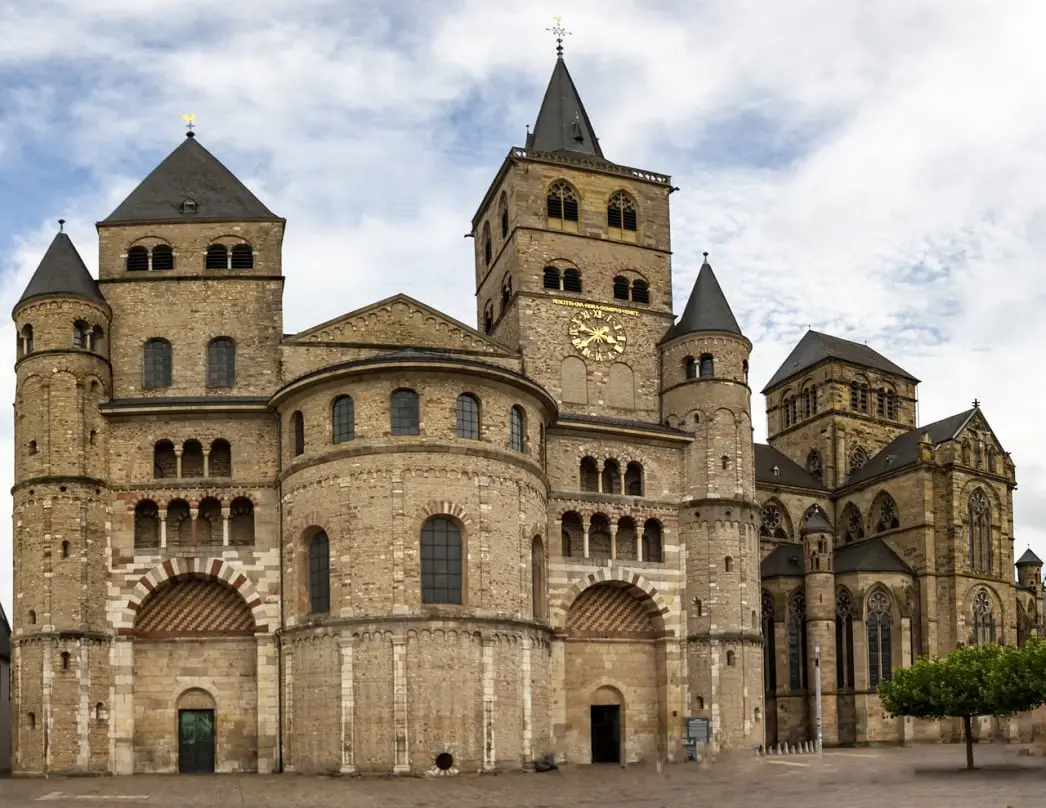
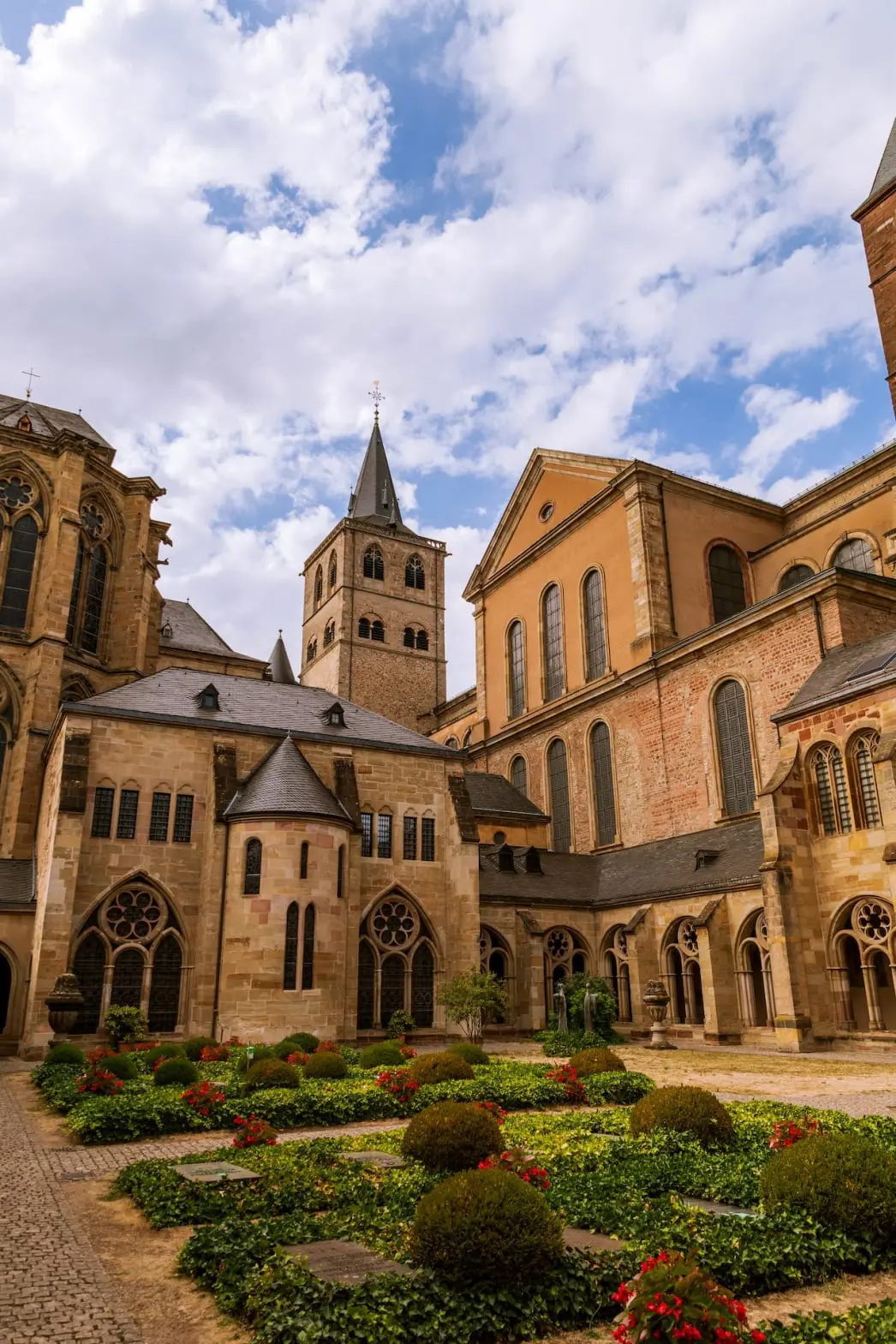
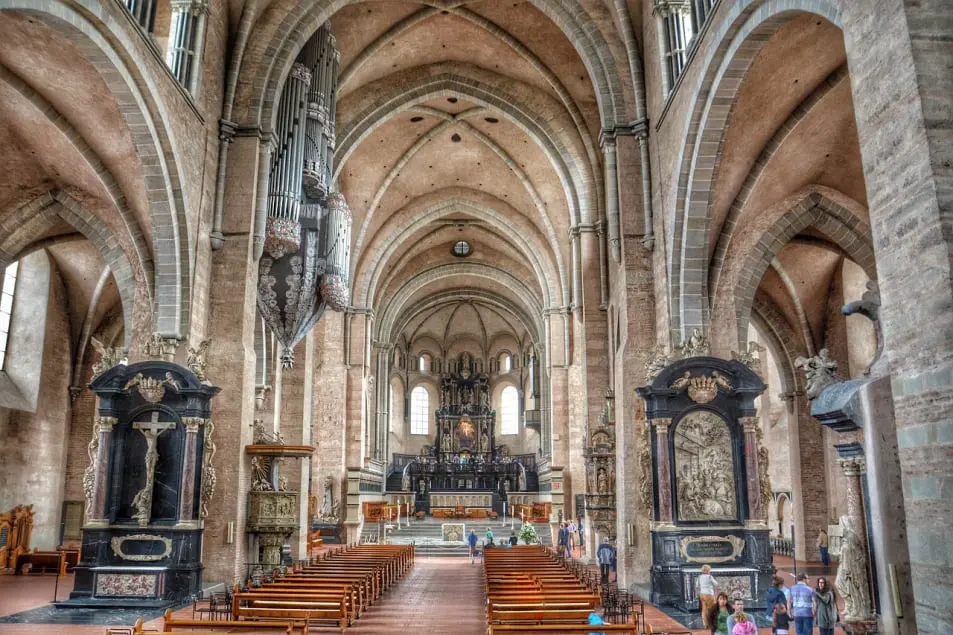
5. TRIER AUDIOGUIDE. THE MARKET SQUARE OF TRIER.
Nestled in the heart of Trier’s city center, this square has, for centuries, been the preferred gathering spot for traders, gossips, and politicians alike.
Since the 10th century, the square has witnessed all sorts of goods being traded: from exotic spices you’d swear held magical powers, to fabrics that would make a Roman emperor feel underdressed. In the hustle of the market, you could find everything. It has hosted weekly markets since time immemorial, offering locals and visitors a taste of regional life through fresh produce and handicrafts.
Although Trier is known for its impressive Roman legacy, the Market Square we see today is primarily medieval in its origin and Renaissance in its attire. Nevertheless, beneath the cobblestones and among the foundations of the colorful houses, the remains of Roman Trier slumber.
The most striking feature of the square is undoubtedly the Saint Peter’s Fountain, adorned with a statue of the city’s patron saint. It is said that the statue has witnessed countless first kisses and hurried farewells and has even seen the odd drunken citizen mistaking it for a very patient listener.
The square is surrounded by colorful buildings that seem plucked from a fairytale, yet are as real as the cobblestone ground beneath your feet. The Steipe House and the Hauptmarkt are the square’s elegant hosts, displaying their ornate facades that have been lovingly reconstructed after World War II left them a bit... disheveled.
The buildings are an eclectic mix of architectural styles ranging from Gothic to Baroque. Among them stands out the Red House, with its Gothic facade painted in a vibrant red that seems almost proud of its intense colors in a world previously dominated by the gray of stone and the white of lime.
And don’t miss the imposing town hall with its foundations dating back to Roman times.
Throughout the year, the square transforms to host festivals and events. The joyful Christmas market stands out, making you feel as if you’re inside a snow globe, turning the square into a forest of wooden stalls, twinkling lights, and heady scents of mulled wine and Christmas sweets. Let’s not forget the Carnival, where even the most serious Trier citizens let down their togas. Prepare for an explosion of costumes and parades that fill the square with music and laughter.
In its day, even Napoleon passed through the Market Square, and it’s told he was so impressed with the city that he ordered the restoration of the nearby Porta Nigra.
In spring, the square fills with terraces, and people gather to enjoy the sun after the cold winter months. In summer, tourists mix with locals in search of souvenirs and a cool place to rest. Autumn brings a palette of golden and red hues, while winter covers the square with a blanket of snow, turning it into a picture-postcard scene. Trier Audioguide.
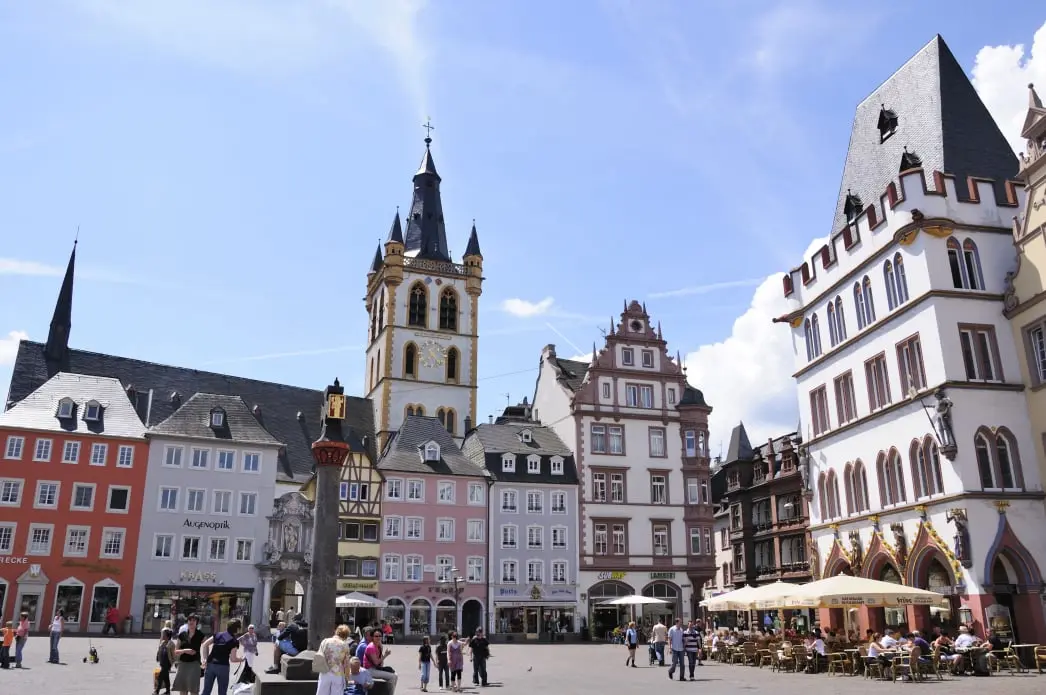
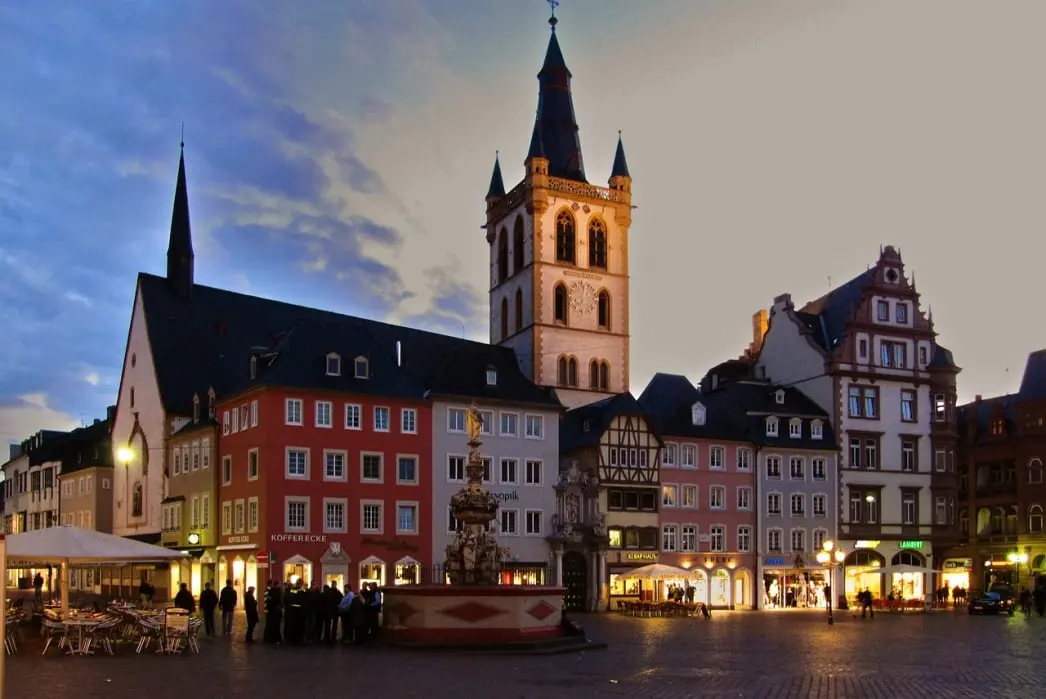
6. TRIER AUDIOGUIDE. THE IMPERIAL BATHS.
At the heart of Trier lie the Imperial Baths, some of the grandest in the vast Roman Empire. And believe me, when the Romans thought big, they did not skimp on stones or saunas!
Built around the 4th century during the reign of Emperor Constantine the Great, who was as 'great' as his name suggests, the Imperial Baths were not just a place for personal hygiene. Oh no, these were the spas of antiquity, where one could sweat out their sins (and the calories from the previous night's feast), debate politics, or simply gossip about the latest sandal fashions in Rome.
The baths were so luxurious they could have made the gods of Olympus blush. Imagine enormous pools, sweating rooms that could rival the heat of the desert, and cool spaces where a Roman could chill faster than Caesar could say "veni, vidi, vici". But the real show was the hypocausts, an underground heating system so ingenious it was probably the envy of the gods of the underworld. Hades himself would have given his stamp of approval to those warm floors! It allowed bathers to enjoy different temperatures in a series of rooms including the caldarium (hot room), tepidarium (warm room), and frigidarium (cold room).
One can walk through the underground, which once housed the fires of the hypocaust, and marvel at Roman engineering. Even in its ruined state, the scale of the complex is impressive and conjures images of everyday life.
The baths also had gym areas and open spaces where people could exercise or simply enjoy the sun.
These baths were meant to be a public bath complex on a scale and opulence that reflected the importance and power of Trier.
But the life of the Imperial Baths was not all luxury and relaxation. During the invasions of the barbarians, these baths turned into a fortress. Parts of the complex were used as a stone workshop and even as housing.
Over the centuries, the baths have gone through various stages, including serving as part of the city's medieval wall. Yes, where once Roman citizens enjoyed a dip, later knights would walk watchful rounds. Let's hope they didn't try to fill the baths with boiling oil instead of water!
It wasn't until the 19th century that excavations were carried out at the site and began to reveal the extent of the Imperial Baths. Excavations continued into the 20th century, uncovering more about the original structure and design of the baths. The Imperial Baths are included in UNESCO's list of World Heritage monuments.
Today, the ruins of the Imperial Baths in Trier stand as an impressive reminder of Rome's power and influence in its glory days. A walk through these ruins can make you feel like an emperor, though without the slaves to carry your towel, of course.
And if stones could talk, oh the stories they would tell! From the secrets whispered in the steam rooms to the rumors of conspiracies hatched in the cold pools, the Imperial Baths have been witnesses to history in flesh and stone. Trier Audioguide.
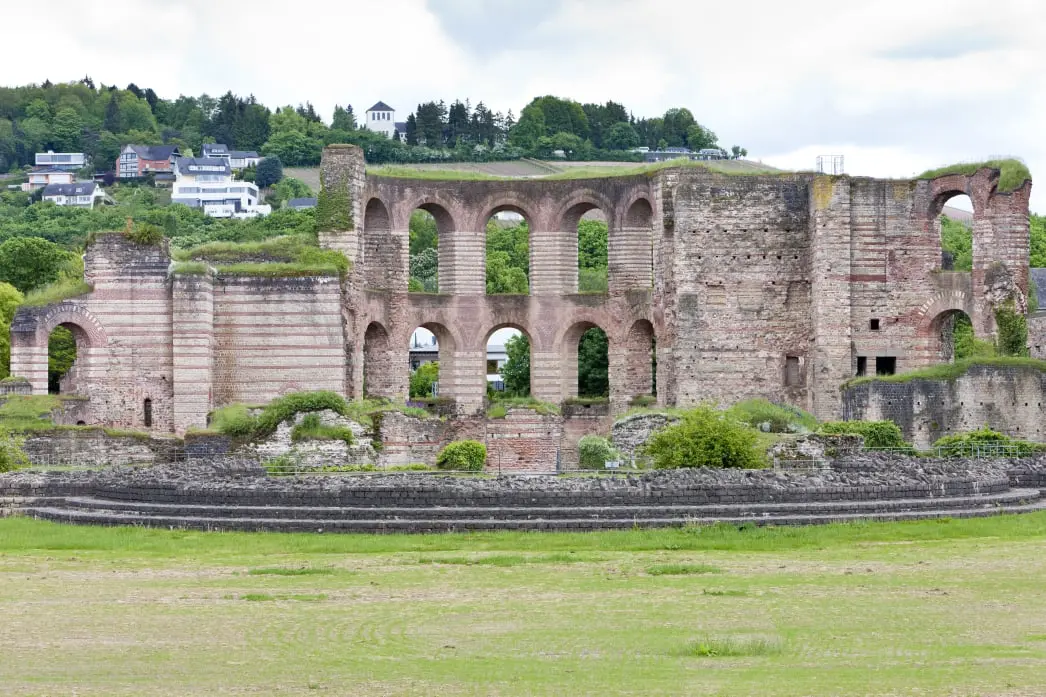
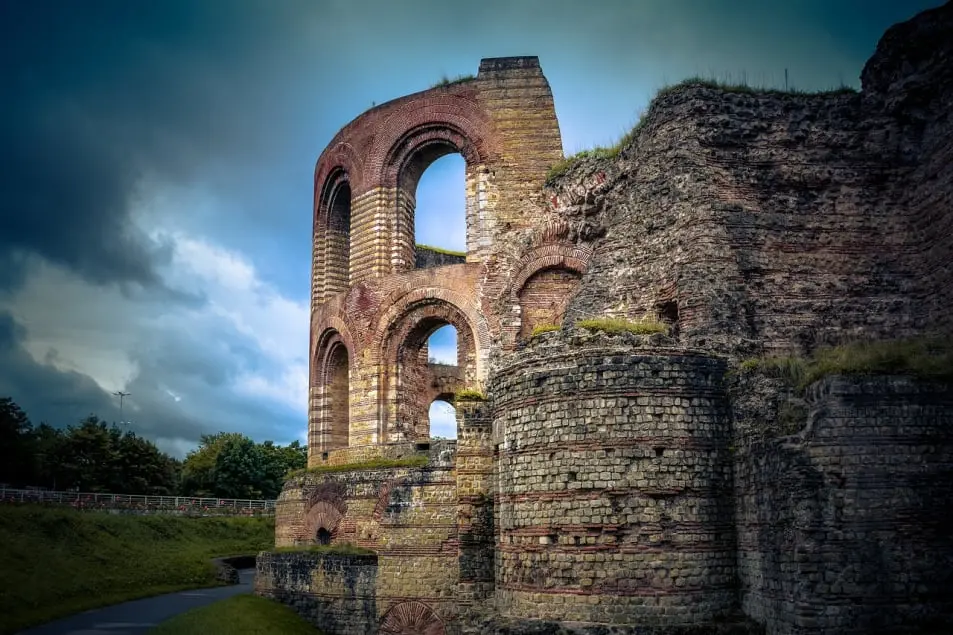
7. TRIER AUDIOGUIDE. THE ROMAN AMPHITHEATRE.
If you've ever dreamed of time travel, the Roman Amphitheatre in Trier is your golden ticket back to the 2nd century, without the need for time machines or quantum conundrums! Located on the outskirts of the ancient Roman city of Augusta Treverorum, this amphitheatre could hold up to 20,000 spectators eager for entertainment.
Now, picture this: you're an ordinary Roman citizen (but with an exceptionally stylish toga!), and you've just heard there's a new show in town. We're not talking about just any show, but one where gladiators, who were the superstars of their era, battle for eternal glory and, well, their lives. As you make your way through the crowd, you think about the incredible piece of engineering beneath your feet.
The Roman Amphitheatre of Trier wasn't just a place for bloodthirsty fights and high-octane theatrical dramas; it was also an architectural and engineering marvel. With a clever design, it included trapdoors and elevators, features that would make today's stage designers blush! It's said that wild animals and gladiators would pop up from the ground like toast in a Roman toaster, stunning the audience and probably their opponents too. A complex system of tunnels and lifts allowed for the surprise introduction of beasts and gladiators into the arena, creating dynamic and dramatic spectacles. The Romans mastered the art of stage manipulation to maximize the emotional impact on the audience.
Gladiator fights were not just a sport, but a ritual laden with cultural and social meanings, where life and death danced on the edge of a sword.
But it wasn't all blood and sand. The amphitheatre was also the stage for public dramas, executions, and during holidays, the ancient version of "free admission for all".
Public executions were both a form of punishment and a means to entertain, and sometimes to impart moral lessons to the population.
If the walls of this stone colossus could talk, they would tell tales of thrill, terror, victory, and, of course, the odd spectator who discovered that togas are not the best attire for European weather.
The symbolism of the amphitheatre should not be underestimated. It was a manifestation of Roman power and civilization, a constant reminder to the citizens and conquered peoples about the strength and culture of the empire. The amphitheatre's ability to host a large number of spectators also reflected the importance and status of Trier within the empire.
Over the centuries, the amphitheatre fell into disuse and was partially swallowed by the landscape, turning into a resource mine for local builders. It wasn't until the 18th and 19th centuries that the site was rediscovered and excavated, revealing the hidden grandeur that had been put to much less glamorous uses, such as gardening and farming.
Today, the Trier Amphitheatre stands among the largest remnants of Roman glory in Germany, a place where you can stroll through the arena and feel history beneath your feet. You can even explore the underground crypts, where gladiators once awaited their turn to take the main stage, although now it's less likely you'll encounter a prowling lion.
A relic of an era when entertainment was truly a matter of life or death!. Trier Audioguide.
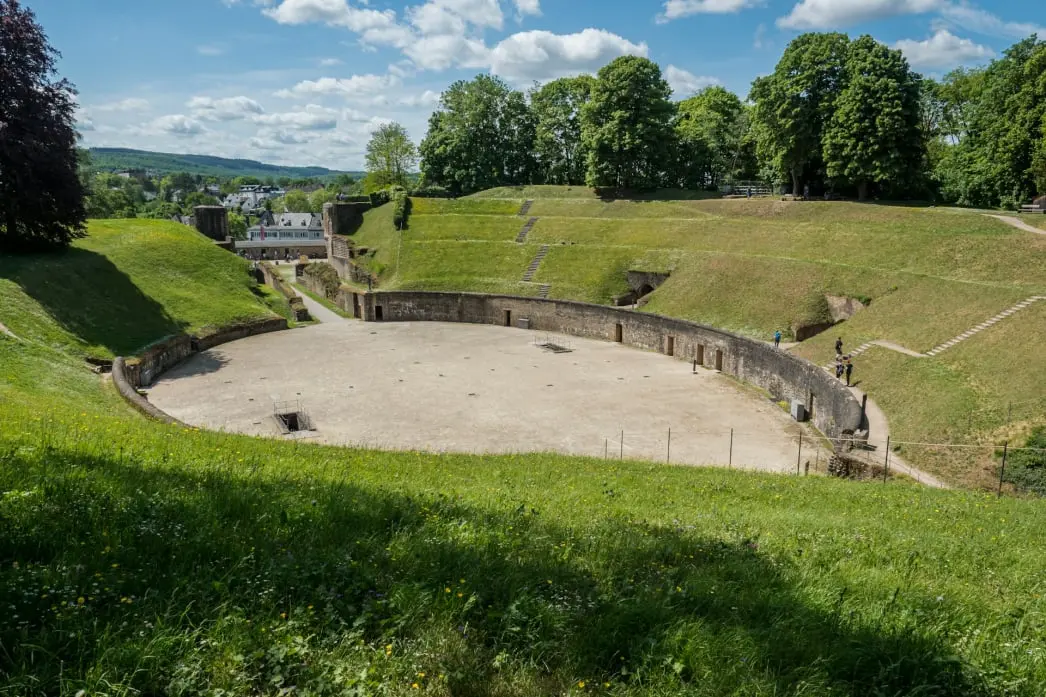
8. TRIER AUDIOGUIDE. THE ROMAN BRIDGE.
This architectural gem that spans the Moselle is not just a marvel of ancient engineering; it's a veteran of infrastructure that still today firmly holds its arches against the flow of time. Built around the 2nd century AD, the Roman Bridge of Trier claims the title of "Germany's oldest bridge." And it certainly takes its job seriously!
Back in the days when togas were the latest fashion and Romans were busy leaving their mark all over Europe, they decided they needed a solid bridge to connect both banks of the Moselle. No makeshift plank would do; it had to be a structure that could withstand the weight of time, legions, carts, and traders.
The Romans, those master builders who didn't know the word 'impossible,' set to work. They used slate stone and dolomite, along with engineering skills that would make many modern architects blush, and created a bridge that has survived almost everything history has thrown at it: floods, invasions, and even the advances of technology.
Have you ever wondered what a work inspection would look like back then? You can imagine the centurion in charge, scrolls in hand, inspecting each arch with a critical eye while Roman workers, dressed in work tunics (which were nothing more than togas with dust stains), secured each stone in place.
Throughout the centuries, the bridge has seen it all. It has witnessed the rise and fall of the Roman Empire, the turmoil of barbarian invasions, the prayers of medieval pilgrims, and it's still here, providing a path over the waters, although the legions have been replaced by tourists with cameras and ice cream in hand.
What's even more astonishing is that parts of the original columns remain intact, despite the thousands of years of history and traffic that have passed over them. It's as if the pillars refuse to retire, holding up the bridge with a sense of duty that would be admirable in any Roman soldier.
In the 18th century, the bridge had to be renovated, but rather than opting for a modern design, architects decided to maintain its Roman style. That's the kind of respect an elder of the bridges commands. Although the pillars are original, the superstructures have been replaced several times over the centuries due to war damage or maintenance needs. During the 20th century, it suffered damages in the world wars but was restored again, maintaining its legacy.
Today, the Roman Bridge is not only a testament to Roman genius but also a reminder that the good lasts. You can stroll across it, touch the stone blocks that have been polished by history, and feel under your feet the vibration of two thousand years of stories. Trier Audioguide.

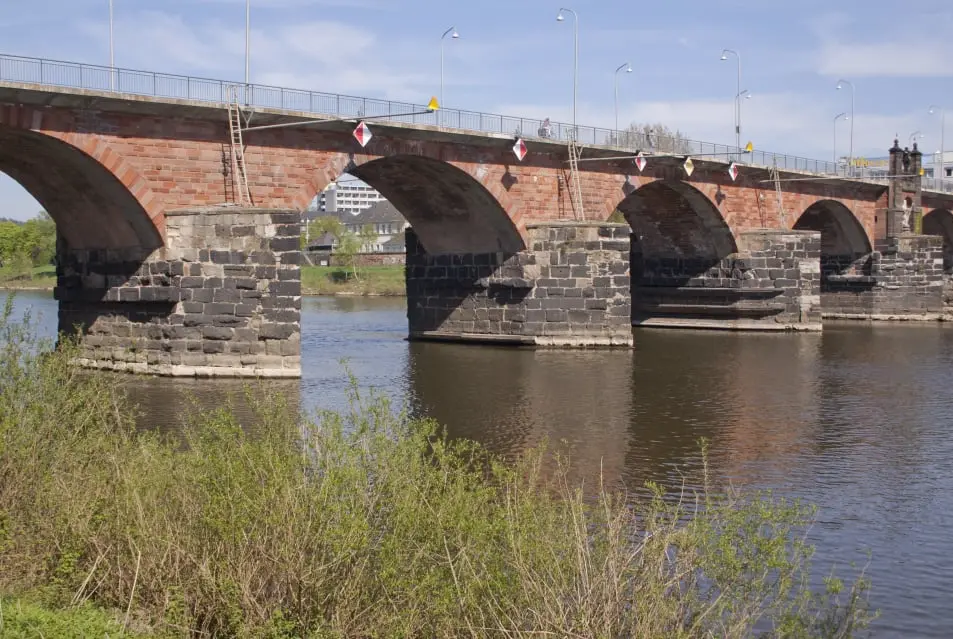
9. TRIER AUDIOGUIDE. THE RHEINISCHES MUSEUM OF TRIER: A JOURNEY THROUGH TIME.
When it comes to historical adventures, the Rheinisches Museum of Trier is like a time machine encapsulated within four walls, taking you on a detailed tour through no less than 2000 years of history.
Founded in 1877, this museum is not only one of the oldest of its kind in Germany, but it is also the custodian of one of the most impressive collections of Roman artifacts outside of Italy. With each step you take in its galleries, you're walking in the footsteps of legionnaires, emperors, and perhaps the occasional bewildered gladiator.
The museum boasts pieces that will make you question whether you've really been paying attention in your history classes. From Roman mosaics so well-preserved they seem to whisper the latest gossip from the Forum, to jewelry that would leave you wondering if Cleopatra forgot her necklace during a state visit.
But it's not just the Romans who are the stars here. The museum offers an intimate look at life along the Moselle River, the liquid heart of the region. Prehistoric pieces, Celtic artifacts, and medieval keepsakes share space, showcasing how this area has been a melting pot of human activity since time immemorial.
One of the crown jewels of the museum is the display of funerary steles and sarcophagi that seem to tell their own tales. Each inscription is a biographical capsule, revealing the hopes and sorrows of those who once called Trier home. And if you listen closely enough, you might hear the echo of a Roman marketplace or the whisper of a medieval prayer.
But don't think it's all ancient at the Rheinisches. The museum combines modern display techniques with its antiquities, using technology to bring the past to life. Touch screens and virtual reconstructions make the experience uniquely engaging.
The museum building itself is a chapter of history in its own right. Its architecture evokes the grandeur of European cultural institutions, and walking through its corridors is a constant reminder of the respect Germany has for its heritage.
The Rheinisches is not just for scholars and history buffs. It's a place where families can bring their budding Indiana Joneses to marvel at the glint of a Roman coin or the intricacy of a medieval brooch.
It's a place where every object tells a story and every room is a chapter in the book of humanity. It's not just a museum; it's a bridge between the past and the present, inviting every visitor to be a part of the ongoing narrative of our history. Trier Audioguide.
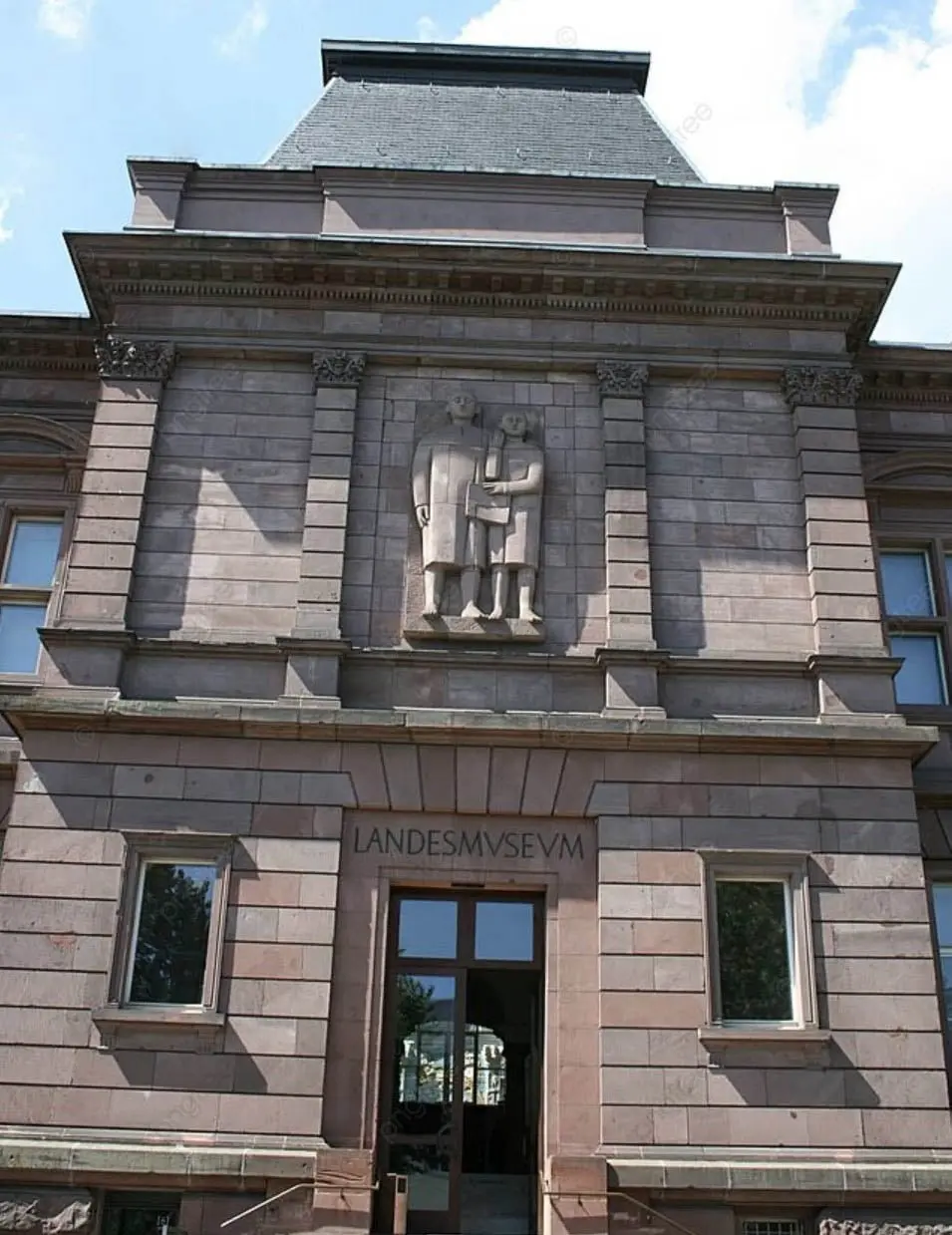
- Language german
- mp3 format
- Language english
- mp3 format
Audio guide devices, Multimedia audio guides,
Audio guide GPS tourist bus-train, charging bases and accessories.
Group guidance systems, headsets, charging cases, tour guide systems accessories.
Audioguides available from mobile devices, web App, downloadable App from Google Store.
Audioguides in several languages, translations, voiceovers. Audio descriptions, signoguides, visual contents for audioguides. 3D Reality.